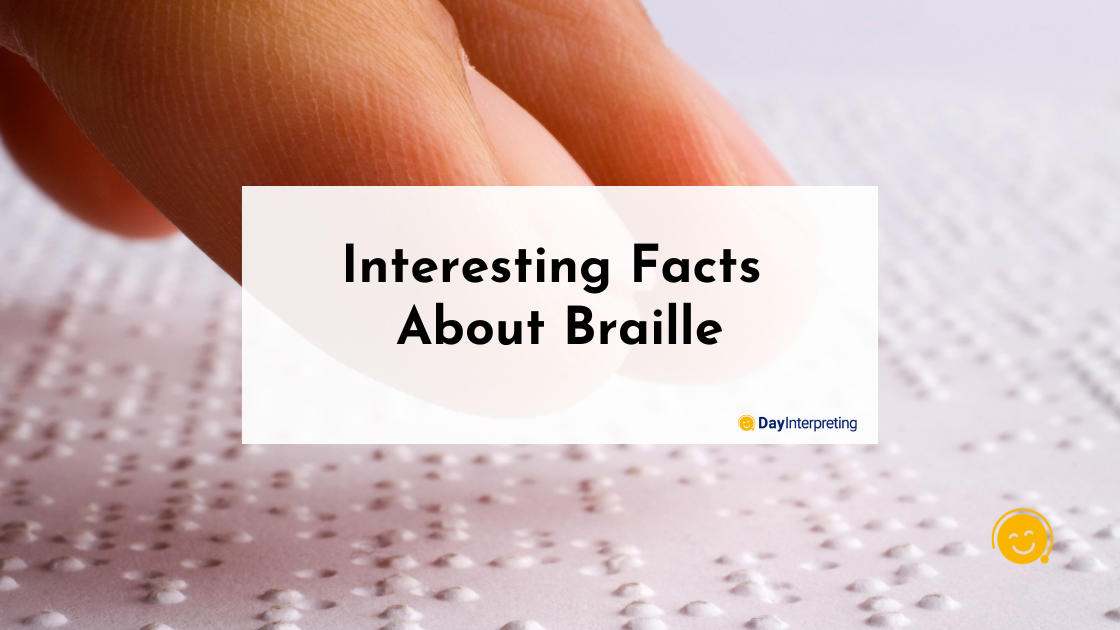At some point or other, we’ve all heard about braille. But how much do we really know about it and its origins? There’s a whole new world waiting to be explored with the system. Keep reading this Day Interpreting post to find out some very interesting facts about braille.
What is Braille?
By definition, braille is a tactile system of reading and writing specially created for those who are blind or visually impaired. The characters in this writing system are made up of raised dots, more commonly referred to as code. There are 63 characters in all, each made up of between 1 to 6 characters that are arranged in a cell or matrix compiled of 6 positions.
Braille is read by lightly passing your fingers over the paper/page.
The History of Braille
Initially, braille was invented as a form of communication to be used in the French military by Charles Barbier. It was a code called ‘night writing.’ As you might be able to guess, it was created for the soldiers to communicate without having to use words or any form of light. At this early stage of its development, night writing was a 12-dot system that would be condensed into half the amount later.
In 1824, a more simplified version of ‘night writing’ was invented called braille by 15 years old Louis Braille. He was blinded at the tender age of 3 from a terrible accident. Given his impairment and while he was still a student, Louis used Barbier’s system as a reference to create his 6 dot system, which would later be named after him.
The unique system that Louis developed consisted of 63 different dot patterns, and each character fits perfectly into a 6-dot cell. They were numbered downward both on the left and right to represent letters. Whenever the dots were preceded with specific numbered dots, they were considered to be numerals.
The Evolution of the System
Of course, there are more specific and technical details that help braille come together as a form of communication. Braille first came into use in 1829 and was later revised and further developed in 1837. However, it wasn’t until 1854 that it was officially adopted to be used in schools ( 2 years after Louis Braille passed away).
Given that the braille system of reading and writing was invented in France, it wasn’t until 1932 that a universal braille code was developed for English speakers. It was officially called Standard English Braille, grade 2.
Today, there have been other systems developed from braille. They are as follows:
- The Nemeth code of braille mathematics and scientific notation, developed in 1965
- Special braille codes for musical notes and shorthand
Interesting Facts About Braille
We’re now at the part in our post we’re sure you’ve been waiting for; the very interesting and fun facts about braille. We won’t waste any more time, so let’s get right into it.
It’s Not Tied to Language
Braille isn’t tied to a language. Instead, it’s defined as a code, which means that braille can be used in just about any language. The braille code contains numerous symbols and rules that form a reading and writing system when put together. This means that it can be applied to just about any language with its own code because it follows the same rules as the regular alphabet.
Toy Companies Support Braille
These days, there are more toy companies that believe in accessibility and inclusivity. As a result of this, they have made toys that cater to blind and visually impaired children. Uno, the card game, is a perfect example. The developers not only made the cards in braille, but it’s also on the packaging too. There are also Leggo bricks that have braille incorporated into their design. The bricks help teach blind or visually impaired children the braille alphabet. There’s also the very popular Rubik’s Cube in braille. If you thought the regular Rubik’s Cube is popular, let’s just say that the one in braille is completely sold out.
Rihanna Loves More Than Just the Way You Lie!
The iconic Rihanna is a fan of braille, so much so that her 2016 album ‘Anti’ features a poem written in braille. In addition to this, the cover of her single ‘FourFiveSeconds’ has the title spelled out in braille.
No Capitalization, Please
As a rule, you’re not supposed to capitalize braille unless you’re referring to the creator of this reading and writing system, Louis Braille.
There’s More Than 1 Braille
There are 2 types of braille; contracted and uncontracted braille. There are 180 letter contractions with 75 short words for English contracted braille. These contracted word forms make it easier and faster to read braille.
That’s a Wrap!
There you have it; some very fun and interesting facts about braille. Here at Day Interpreting, we’re all about bringing people together by breaking down language and communication barriers.
Don’t forget to download the Day Interpreting app to get started today.





0 Comments